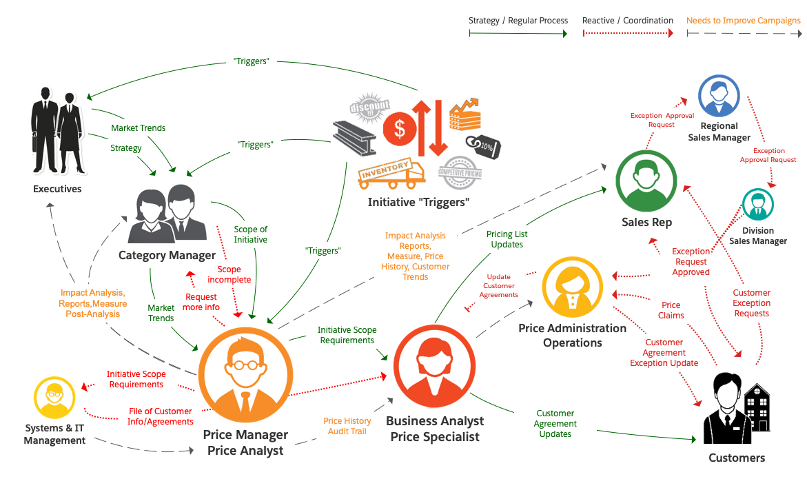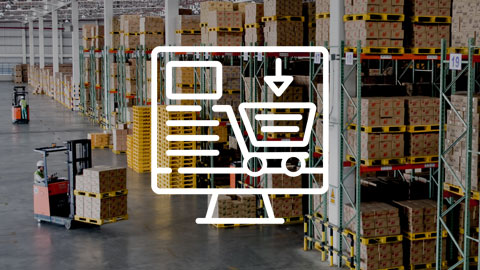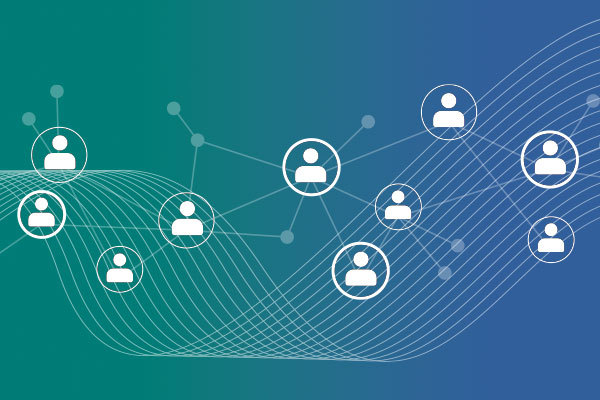What is a Dynamic Pricing Engine?
By Zilliant
May 24, 2023
Table of Contents
Dynamic pricing is a well-known term. Yet, if you were to ask 10 pricing experts to define it, you could very well get 10 different answers! A dynamic pricing engine is important for executive and pricing leaders seeking to break free from the limitations of pricing in manual tools.
In this post, we'll cover B2B dynamic pricing and dynamic pricing engines from all angles.
What is a Dynamic Pricing Engine in B2B?

To understand dynamic pricing engines and their business impact, consider these questions:
How quickly can you respond to new pricing triggers such as cost changes or competitive price changes in the market? Can you update prices in real-time across channels without arduous manual effort? Can your current pricing tools support a responsive pricing strategy? Do your eCommerce prices honor existing customer relationships? Can you serve up the right price that wins new business without sacrificing margin? Are your prices good enough to sell new items to customers, without talking to a sales rep or needing to negotiate?
Depending on unique business criteria, these capabilities should be present in any solution coined as “dynamic.” Market-leading dynamic pricing engines can address all of the above questions and are critical to keep up with customer expectations.
A dynamic pricing engine is responsible for ensuring your prices are relevant to market and channel conditions at any given point in time. When prices can be updated in real-time to match market conditions, you've changed the game.
While the definition is simple, achieving it isn't as straightforward. Traditional spreadsheets and disparate data sources make it nearly impossible. The reason? The information grows stale before the data can be analyzed, let alone acted upon.
Speed and flexibility have never been more important in the world of B2B and those values extend to the pricing function. Relevant, real-time pricing guidance delivered to every sales channel gives companies a leg up on competitors. Meanwhile, internal complexities demand an accurate, fast and automated response in order to achieve your pricing strategy.
Dynamic pricing software combines key elements of price optimization and price management to deliver relevant prices to all sales channels.
Read More - Dynamic Formula Pricing in Specialty Chemicals Manufacturingand What are the Best B2B eCommerce Pricing Strategies
How Does Real-Time Pricing Improve Customer Experience?

B2B enterprises are working hard to improve their digital experiences, and some areas are more valuable investments than others. One of the highest drivers of customer satisfaction and superior consumer experience is personalized, transparent and highly relevant pricing, delivered instantly.
B2B customers simply expect a B2C-like experience from business suppliers, especially after 2020's drastic shift to virtual everything. Modern B2B buyers want to shop for industrial hoses, construction materials and configured products like they shop for groceries on Amazon.
The pricing implications of this shift are immense. B2B pricing is complex, but customers expect prices to be fair, accurate, and personalized. Even for large quotes, they expect prices to reflect market conditions in a way that is tailored to them.
Traditional approaches to setting prices can make it worse when something happens that requires a price change. Dynamic pricing marries business strategy with technology to better serve customers. Dynamic pricing is a vision for pricing that exists on a spectrum. That spectrum contains several stages that will apply to different businesses at different times. We'll explore these different stages through real use cases. First, let's take a deeper dive into the components of a dynamic pricing strategy.
Learn More - Real-Time Market Pricing for eCommerce Distribution | Real-Time Market Pricing for Salesforce B2B Commerce
What is a Dynamic Pricing Strategy?
Learn how to implement dynamic pricing as part of a stronger commercial strategy.
Triggers
Digital commerce creates more data in a business and a faster rate of change. As the world becomes more digitized there are more data points to incorporate into pricing, sales and commercial decisions. Examples are quotes you did not win, IoT data, and eCommerce data like pageviews and cart abandonment metrics.
At the exact same time, market conditions and business dynamics are changing at an increasingly fast pace. This leaves companies scrambling to respond to pricing triggers, like cost changes, tariffs, competitive pricing, inventory status, and inflation. Once predictable and manageable, pricing triggers are happening much more frequently and haphazardly.
Read more: How to Counteract Inflationary Pressure
For instance, competitor prices are much easier to access today due to increased price transparency. Maybe you never want to be five percent higher or lower in price than your competitor. That strategy is hard to execute without the ability to use data in real time to dynamically change pricing.
While those outside of the pricing function may assume changing prices is a simple endeavor, the reality is much more complex. The process involves a number of stakeholders in an organization. Below is a rendering of the pricing process we commonly observe within B2B companies:

This chaotic spiderweb makes it hard to respond to a market trigger when time is of the essence. Dynamic pricing moves you from trigger to transaction faster and smarter.
Price Determination
Pricing triggers impact how companies price their products and services, so price updates need to happen across all pricing modes. The price modes can include list, matrix, eCommerce, spot/negotiation and customer specific pricing. Price moves need to be relevant to customer relationships as well as the company's bottom line and pricing strategy. Traditional manual pricing methods often fail to support this.
For instance, a Zilliant metals distribution customer has all its material costs driven by the London Metal Exchange. The company replaced spreadsheets with a much faster, more agile way of understanding how those costs changes flow into product cost for its dynamic pricing strategy.
Data science and pricing software can consume data inputs in real-time and dynamically adjust prices based on pre-defined strategies. This enables companies to turn market triggers into responsive pricing tactics. If you respond to every trigger manually, you will be buried in data and unable to keep up.
Companies that try this manual approach either become overwhelmed or revert back to simple rule-of-thumb behaviors. Market leading price optimization and management software like Zilliant Price IQ® and Zilliant Price Manager™ make traditional manual efforts dynamic.
In addition to becoming more dynamic, it's important to be more scientific in how you approach pricing. By doing so, you can deploy more strategic pricing strategies. For example, utilizing cart abandonment data for strategic pricing discounts in your eCommerce channel.
Price elasticity measurement can help you understand how changes in price will affect your sales volume and margins at a granular level. This can help you test and predict the outcomes of pricing strategies before publishing them. These price updates need to be connected back to sales channels in a timely fashion for them to be useful.
Price Delivery

Prices should be easily integrated into any system, whether it be a CRM, CPQ, ERP, eCommerce, or a home-grown solution. This way, sales teams or customers can easily retrieve them when needed. However, legacy ERP systems are often slow and not able to deliver prices in real-time to other commercial systems.
Don't embark on an expensive and time consuming custom ERP project. Instead, gain immediate benefit by bolstering your ERP with a real-time pricing engine.
Using a real-time pricing engine, prices are dynamically calculated and delivered in real-time to any commercial application. Companies are driving significant value, particularly, with dynamic pricing for eCommerce, the most complex and competitive pricing environment in most sectors.
Real-time price delivery requires a robust, highly-available REST API to link data sources to pricing tools and sales channels seamlessly. Zilliant's Real-Time Pricing Engine™ makes real-time data transfer, millisecond price lookups and complex quote calculations possible. With its 99.99% SLA, you can rely on uptime, speed and scalability. makes real-time data transfer, millisecond price lookups and complex quote calculations possible. With its 99.99% SLA, you can rely on uptime, speed and scalability.
Pricing software vendors may offer a complementary application for sales consumption as well. For example, Zilliant offers Deal Manager™ to streamline the creation, maintenance and renewal of customer agreements. Additionally, Zilliant Sales Planner™ makes good on the promise of CRM by giving sales reps margin and revenue growth actions. When integrated with dynamic pricing software, each can ensure agreements and transactions are executed at market-aligned and profitable price points.
Read More: What is Deal Management?
Intelligent Automated Negotiation
Dynamic pricing software early adopters are taking their dynamic strategies a step further by automating negotiation processes and making intelligent recommendations to customers on what else they should buy.
The high-touch discounting and negotiation processes - wherein customers request lower pricing and the sales rep must work with internal teams for approvals or counter-negotiations - waste time for the seller and are a non-starter for the buyer.
Customers are increasingly self-sufficient and prefer to get quotes without speaking to a sales representative. If you don't offer automated negotiation, your buyers will find a competitor who does.
This automated process streamlines the negotiation step through dynamic pricing software and a real-time API. The ability to do this at scale is an absolute game-changer for sales operations and pricing teams. Done right, more than 80 percent of quotes don't require human review. This allows teams to spend more time on bigger, strategic deals.
Creating a responsive negotiation experience for customers on digital platforms helps to improve customer satisfaction. Your vision of having customers doing new business effectively online is achievable through dynamic, automated pricing capabilities.
Read More - Price Elasticity in B2B: The Real Meaning of Optimization
Dynamic Pricing Examples

There are many different use cases for dynamic pricing in B2B. Some companies are further down the path than others, and companies require varying levels of sophistication to make a measurable impact. We'll examine some recent real-world use cases below.
Replacing Legacy Agreement and Pricing Capabilities
A carpet and flooring manufacturer developed its legacy agreement management and pricing system over 40 years. Though it served them well for many years, the system was not agile enough to support its 1,400 sales reps and increasing agreement volume, necessitating more flexible pricing and approval workflows.
The company has made Zilliant its system of record for millions of customer price agreements and utilized Deal Manager™ for mobile agreement management. Combining this foundation with Real-Time Pricing Engine™ has allowed the company to automatically evaluate every incoming order to determine if price approval is required and by whom.
Real-Time SAP Integration for Dynamic Price Optimization
An industrial manufacturer wanted to deliver prices from Price IQ and Price Manager into the pricing procedure in Atlas by SAP in real-time. This would help the company keep up with market triggers and execute its corporate pricing strategy dynamically.
Zilliant's API platform brings the company's data into SAP Price Conditions in real-time. This eliminates the need to manually bulk-load load millions of records. The resulting solution delivers dynamic pricing without any need to modify SAP when changes occur in the Zilliant pricing system.
Dynamic eCommerce Pricing
A Zilliant customer wanted to leverage its eCommerce data to stay a step ahead of the competition. Zilliant's dynamic pricing software and API allows the company to use its pageview, cart abandonment and inventory availability data to set multiple discounting strategies for eCommerce prices. For example, high inventory and pageviews with low conversion might indicate price is too high.
This approach makes it easier to set smart discount strategies. It allows the user to easily pull in and analyze disparate data sets, while adjusting discounting breaks on the fly. For example, quickly setting a 30 percent price discount at a quantity of 20 units, when data indicates prices are too high, to move inventory.Thanks to a real-time API, the new prices or discounts are instantly updated in eCommerce.
Learn More - How to Become a Digital Commerce-Powered Manufacturer
What are the Benefits of Dynamic B2B Pricing?
Companies who have implemented dynamic pricing become more responsive, automated and intelligent in pricing decisions and, ultimately, price execution. The resulting speed-to-market combined with scientific accuracy in all channels is a game-changer for B2B organizations.
When you have dynamic, optimized prices delivered through a high-performing API, you can solve problems in real time. B2B companies also stand to significantly increase revenue and margins while delivering the tailored experience customers expect.
This immediately available, tailored pricing is consistent across channels and accurately reflects current market conditions and customer relationships.
Dynamic pricing also allows organizations to:
Reflect the current market price calculated and/or optimized against a variety of inputs Use more data from varied, unlimited sources Deliver pricing aligned with strategy across channels in real time Automate approvals, negotiation, counterproposals Deliver personalized cross-sell and up-sell recommendations
To get started on your dynamic pricing journey, contact a Zilliant pricing expert today.
FAQ
What is Dynamic Pricing?
Dynamic pricing means that your customers see prices that are relevant to market and channel conditions at any given point in time.
Learn More: What is Dynamic Pricing?
What is Price Optimization?
Price optimization is a process that utilizes artificial intelligence to measure price elasticity and alignment optimization to predict the outcomes of various pricing strategies and generate pricing that is market-aligned while meeting a businesses' margin and revenue goals.
Learn More: Price Optimization - A Guide to Maximizing Profit
What is Price Elasticity?
Price elasticity is a predictive measurement of how a change in price will impact volume by statistically measuring what drives price response in the market. In practical B2B applications, it's one step in the price optimization process, which ultimately allows business users to conduct what-if scenarios on various P&L objectives and understand margin and volume impacts before publishing new prices.
Learn More: What Works When Traditional Price Elasticity Fails
What is Price Segmentation?
Price segmentation uncovers the variables that explain historical pricing behaviors exhibited in a company's order or quote history. There are many critical factors that drive each unique price point: market conditions, product value, product hierarchy, customer spend, order size, discounts, regional dynamics, competitive factors, cost factors, margin targets, company growth goals and more.
Learn More: Transforming Your B2B Pricing Strategy and Processes
What is Pricing Software?
Originating in the travel and hospitality industries as revenue management software, pricing software has been developed to serve industries ranging from retail to B2B to financial services and telecommunications companies analyze, manage, optimize and execute prices.
Learn More: What is Pricing Software?
What is a Real-Time Pricing Engine?
A real-time pricing engine executes real-time price calculations (or real-time price builds) in response to calls from any commercial system, incorporates an unlimited number of disparate data sets into the pricing engine, performs complex calculations on demand, and enables real-time price delivery back into commercial systems.
Learn More: What is a Real-Time Pricing Engine?





